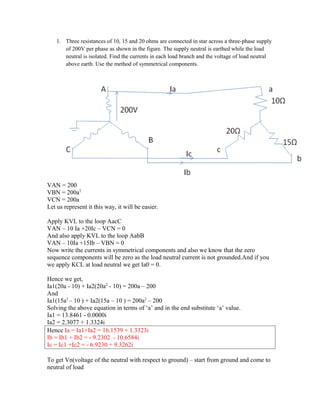Unit 2 samplesolutions
•Descargar como DOC, PDF•
1 recomendación•864 vistas
Symmetrical Components, Per Unit Representation
Denunciar
Compartir
Denunciar
Compartir

Recomendados
Reflection and Transmission coefficients in transmission lineReflection and Transmission coefficients in transmission line

Reflection and Transmission coefficients in transmission lineRCC Institute of Information Technology
Recomendados
Reflection and Transmission coefficients in transmission lineReflection and Transmission coefficients in transmission line

Reflection and Transmission coefficients in transmission lineRCC Institute of Information Technology
Más contenido relacionado
La actualidad más candente
La actualidad más candente (20)
Distribution System Voltage Drop and Power Loss Calculation

Distribution System Voltage Drop and Power Loss Calculation
Destacado
Destacado (20)
TPs-TDs : Travaux Pratiques & Dérigés (version 2014-2017) Génie Electrique/Ex...

TPs-TDs : Travaux Pratiques & Dérigés (version 2014-2017) Génie Electrique/Ex...
Similar a Unit 2 samplesolutions
Similar a Unit 2 samplesolutions (20)
BEF 23803 - Lecture 8 - Conservation of Complex Power.ppt

BEF 23803 - Lecture 8 - Conservation of Complex Power.ppt
Calculations of a.c distributions methods & 3 phase unbalanced loads &...

Calculations of a.c distributions methods & 3 phase unbalanced loads &...
Más de Abha Tripathi
Más de Abha Tripathi (16)
Conventional sources of energy (power generation) 01

Conventional sources of energy (power generation) 01
Unit 2 samplesolutions
- 1. 1. Three resistances of 10, 15 and 20 ohms are connected in star across a three-phase supply of 200V per phase as shown in the figure. The supply neutral is earthed while the load neutral is isolated. Find the currents in each load branch and the voltage of load neutral above earth. Use the method of symmetrical components. VAN = 200 VBN = 200a2 VCN = 200a Let us represent it this way, it will be easier. Apply KVL to the loop AacC VAN – 10 Ia +20Ic – VCN = 0 And also apply KVL to the loop AabB VAN – 10Ia +15Ib – VBN = 0 Now write the currents in symmetrical components and also we know that the zero sequence components will be zero as the load neutral current is not grounded.And if you we apply KCL at load neutral we get Ia0 = 0. Hence we get, Ia1(20a - 10) + Ia2(20a2 - 10) = 200a – 200 And Ia1(15a2 – 10 ) + Ia2(15a – 10 ) = 200a2 – 200 Solving the above equation in terms of ‘a’ and in the end substitute ‘a’ value. Ia1 = 13.8461 - 0.0000i Ia2 = 2.3077 + 1.3324i Hence Ia = Ia1+Ia2 = 16.1539 + 1.3323i Ib = Ib1 + Ib2 = - 9.2302 - 10.6584i Ic = Ic1 +Ic2 = - 6.9230 + 9.3262i To get Vn(voltage of the neutral with respect to ground) – start from ground and come to neutral of load
- 2. Vn = 200 - 10*Ia Vn = 38.4614 -13.3234i Magnitude = 40.7037 2. The voltages at the terminals of a balanced load consisting of three 20 ohm Y-connected resistors are 200(0◦), 10(255.5◦) and 200(151◦) V. Find the line currents from the symmetrical components of the line voltages if the neutral of the load is isolated. What relation exists between the symmetrical components of the line and……….. Solution : Convert star to delta and you get the value of all resistances which are balanced as 60 ohms Iab = 200/60 = 10/3 (00) Ibc = 100(255.50)/60 = 5/3(255.50) Ica = 200(1510)/60 = 10/3(1510) Using symmetrical components resolution formula involving A-1 From this we get Iab1 = 2.7(15.10) Iab2 = 1.03(- 44.530) Ia1 = Iab1 – Ica1 = 4.67(-150) Ia2 = Iab2 – Ica2 = 1.784(-14.50) Ia = Ia1 + Ia2(zero seq. Comp. Currents will not appear in the lines of delta connected or star connected load with neutral isolated) Ia = 6.453(-14.870) Ib1 = a^2Ia1 = 4.67(-1350) Ib2 = aIb2 = 1.784(105.50) Ib = Ib1+Ib2 = 4.105(-156.90) Ic1 = a*Ia1 = 4.67(1050) Ic2 = a^2 Ia2 = 1.784(-134.50) Ic = Ic1+ Ic2 = 4.066(127.40) There the power dissipated in 3 phase 20 ohms resistors is
- 3. P = Ia^2(20)+ Ib^2(20) + Ic^2(20) = (6.453^2 + 4.1^2+ 4.066^2)(20) P = 1500W
